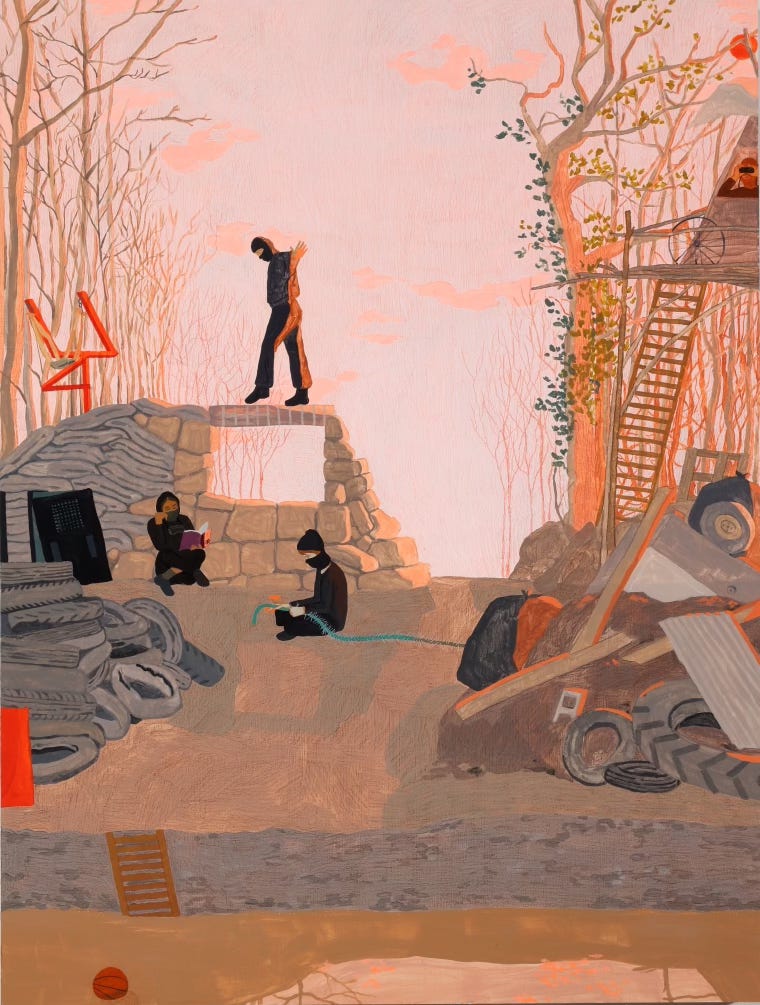What’s left? 2024.
In the heart of the East Village lies the small but vibrant MARCH Gallery, a politically-minded, figurative-based art hub for artists interested in the intersection of revolt and culture. Dianna Settles’ new show, “Enemy of the Century,” is currently on view through June 7. It’s an evocative must-see exhibit.
Not every revolutionary is out on the front lines. This isn’t an excuse for inaction, just a statement of fact. Someone—often a woman—has to feed those fighting for greater autonomy. Settles’ work is filled with these quiet moments, before and after revolt, demonstrating the tender acts of care required to sustain movements.
At a walkthrough a few weeks ago, Settles spoke in length about her process. She joked sometimes comrades were more interested in her work about riots than cooking. Familiarity allows for such intimate conversations about connection and potency. Settles peoples her landscapes with people she knew, often shifting their role in the struggle to something new entirely—just so they wouldn’t be so identifiable. Sometimes a painting is haunted by the ghosts of friends and heroes from across time and space even if they look like one big happy family in Settles’ work. I had to scribble furiously to get down the numerous names of encampments, radicals, and books she mentioned during her talk. (The crisp exhibition text by Keenan O’Sullivan explores some of these ideological influences.) I’ve long admired the way she can paint the political in such alluring hues. Her work is buoyant, bright, dappled with cascading orange and green light. Fruit and oysters litter long, luxurious picnics. Bodies of all kinds rub up against each other. The erotic is vulnerable. (An Old Rebirth features a beautiful woman in a slip helping another out of handcuffs.) The rain outside the window sets up a cozy tableaux, coloring the time spent sheltering together, gathering resources both material and mental for the coming winter.
As we walked through the two long rooms of paintings, figures I recognized appeared before me. Friends, even. A world of communion in bright turbulent vermilion, bronze, and chestnut, crowded and free. Often, Settles paints large groups of individuals each mesmerized by their own pursuit that somehow constitute a disparate whole. There’s unity in her brush strokes. Settles joked she used to be a printmaker, explaining her geographic, color-blocked compositions.
Like spring, the transitions in Settles’ show are swift, lush, and verdant. Four small panels in the second room explore men pruning and apple picking across the seasons. The bare trees against slick, opaque hills and flat periwinkle skies contrast the sinewy leaves in We shall live the simple life & keep each other (2024). The unending sheet cake sky recalls the Midwest, the long rolling greens of Settles’ current residence in Kentucky.
Three 48 x 32 panels crown the second room, each displaying a bustling section of a walled anarchist commune in France that Settles once visited. The titles alludes to both the global rise in fascism and the “dawn of a paradise of delight.” The enemy of in the exhibition title could refer to the crackdown on those seeking to Stop Cop City, or it could just as easily refer to the global creep of authoritarianism. Instead of giving into doomerism, Settles’ work offers an antidote. Get busy. Agitate, post on the activities board, read theory on the lawn, raise the communal children, dye the wool, collect the fruit.
To go beyond resistance…, 2022. (Not part of the exhibition, but another Settles piece)
Children play a large role in “Enemy of the Century.” Their needs, yes, but also their capabilities. They can, and should, have idle time—but they can also join in the adults’ chores and leisure activities. There’s no better time to start making art than when cynicism has yet to cloud your mind. Children offer new visions, surprising and brutal solutions to immense problems. They remind us it can be so simple. How do we know when—and how—to continue the work? When to abandon something and move on to the next? As a child, I saw as a child. Things were intuitive, associative, endless. Time was a game. Watch it stack up, watch it fall down. Joy and envy, despair and triumph, all transitional states. Perhaps, reclaiming a psychoanalytical sense of “play” would be helpful. To imagine revolt not just as a long tumultuous tunnel, but also a space to create Olam Ha-Ba, the world to come. I would like to learn how leisure and labor can be reclaimed from the grip of capital—of worth. This is not easy. Nor are we living with endless time to create such a world. Plenty of Settles’ most beautiful paintings in her new show are stark evocations of winter, one of which alludes to grumbling wildfires.
If such a broad, political project is to be undertaken, children can—and should—instruct us. In Our work will be done when we can give these young ones a new world… (2025), Settles crafts a self-portrait on the brink of birth, her tattooed pregnant body poised with a book, a black goose muddling around the flowers, soaking up knowledge to create new patterns for a new generation.
Art purifies, through catharsis…, 2025.
A parable, 2024.







Beautiful words!